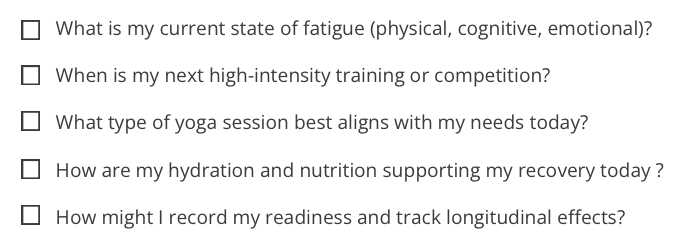Integrating Ancient Wisdom with Modern Science: Yoga for High Performance Athletes
In elite sport, recovery is a decisive factor that determines whether training stress becomes performance adaptation or maladaptation. The evidence is clear: consistent recovery enables the restoration of homeostasis, repair of micro-damage, and the recalibration of the nervous system, which together underpin long-term performance and resilience (Bishop, Jones, & Woods, 2008; Kellmann et al., 2018).
However, in the context of congested schedules, multiple daily sessions, and travel demands, athletes and teams often focus narrowly on traditional recovery modalities, such as nutrition, sleep, and physical therapy, while underutilizing holistic strategies. This is where yoga, an ancient practice grounded in balance and restoration, offers a unique, evidence-aligned solution. Yoga is more than flexibility, it is a strategic recovery and regeneration intervention that is both a preventive tool against maladaptation and a performance amplifier.
In this post, we will explore how yoga bridges the gap between ancient wisdom and modern sports science, supporting physiological recovery, mental resilience, and long-term performance sustainability. You will learn how to integrate yoga safely and effectively into high-performance programs, without overloading the system, and how to align each practice with your individual recovery needs.
Bridging Ancient Wisdom and Modern Science
At its core, yoga embodies the same recovery principles modern sports science identifies: balance between exertion and restoration, mindful regulation of energy, and structured transitions between stress and recovery. Research in overtraining and recovery confirms that neglecting these cycles impairs adaptation and elevates injury risk (Kenttä & Hassmén, 1998; Venter, 2014).
By strategically integrating yoga into recovery and regeneration programming, athletes and teams can:
Accelerate homeostasis: Facilitate faster return to physiological baseline.
Enhance allostasis and adaptation: Support muscular and neural recovery and flexibility for greater training efficiency.
Fortify resilience: Build psychological capacity to manage stress, pressure, and fatigue.
Yoga as a Recovery Modality
Yoga integrates movement, breath regulation, and mindful awareness, a triad that supports both physiological and psychological recovery.
Physiological recovery: targeted mobility work promotes circulation, facilitates metabolic clearance, and relieves neuromuscular tension. These effects mirror active recovery, which has been shown to accelerate lactate clearance and improve perceived readiness (Ortiz Jr. et al., 2019).
Psychological recovery: Breathwork, mindfulness, and meditation cultivate autonomic balance, downregulate sympathetic arousal, and restore attentional control, mechanisms that align with Kellmann’s framework for psychological recovery (Kellmann et al., 2018).
Together, yoga fosters an adaptable athlete capable of sustaining performance across heavy training blocks and competition cycles.
Cautions: Honor Your Body, Prevent Injury
While yoga offers powerful recovery benefits, it should not become another form of heavy exertion or competition. Each practice should be guided by interoception, awareness of internal signals such as breath, tension, and fatigue.
Avoid forcing flexibility or holding postures through discomfort; use props or modify positions as needed.
Remember that “your body, your practice” means listening to what your system needs that day, some days call for stillness and restorative poses, others for gentle movement.
Elite athletes often carry micro-fatigue or asymmetries from repetitive training loads; these must be respected to prevent strain or overextension.
Maintain communication between athlete, coach, and physiotherapist when introducing new movement modalities.
Yoga’s intent is to restore and regenerate, not to add additional load. When practiced with self-awareness and respect for recovery cycles, it becomes a precision tool for performance longevity.
Practical Implementation: Aligning a Yoga Session with the Athlete’s Needs
The following are examples of opportunities to align yoga with athlete needs.
Recovery Checklist for Yoga Integration
For most effective yoga integration into recovery and regeneration strategies, it may be helpful to check-in and ask:
Reflection Prompts
After yoga practice, do I feel more energized, calmer, or both?
Has my perception of stress or mental fatigue changed?
How do I notice the difference in readiness for the next session or match?
Which techniques had the strongest impact, and how might I refine them for future sessions?
Explore Your Regeneration Potential with Yoga
Yoga is more than flexibility, it is a strategic recovery and regeneration intervention. Begin with one session per week, pairing restorative postures with mindful breathing. Track readiness, sleep, and perceived recovery. Over time, scale frequency to integrate yoga as both a preventive tool against maladaptation and a performance amplifier. By bridging ancient wisdom with modern science, athletes and teams can unlock deeper layers of resilience, recovery, and high performance.
References
Bishop, P. A., Jones, E., & Woods, A. K. (2008). Recovery from training: A brief review. Journal of Strength & Conditioning Research, 22(3), 1015–1024.
Kellmann, M., Bertollo, M., Bosquet, L., et al. (2018). Recovery and performance in sport: Consensus statement. International Journal of Sports Physiology and Performance, 13(2), 240–245.
Kenttä, G., & Hassmén, P. (1998). Overtraining and recovery. Sports Medicine, 26(1), 1–16.
Ortiz Jr, R. O., Elder, A. J. S., Elder, C. L., & Dawes, J. J. (2019). Effectiveness of active recovery interventions on athletic performance. Journal of Strength & Conditioning Research, 33(8), 2275–2287.
Venter, R. E. (2014). Perceptions of team athletes on the importance of recovery modalities. European Journal of Sport Science, 14(sup1), S69–S76.



